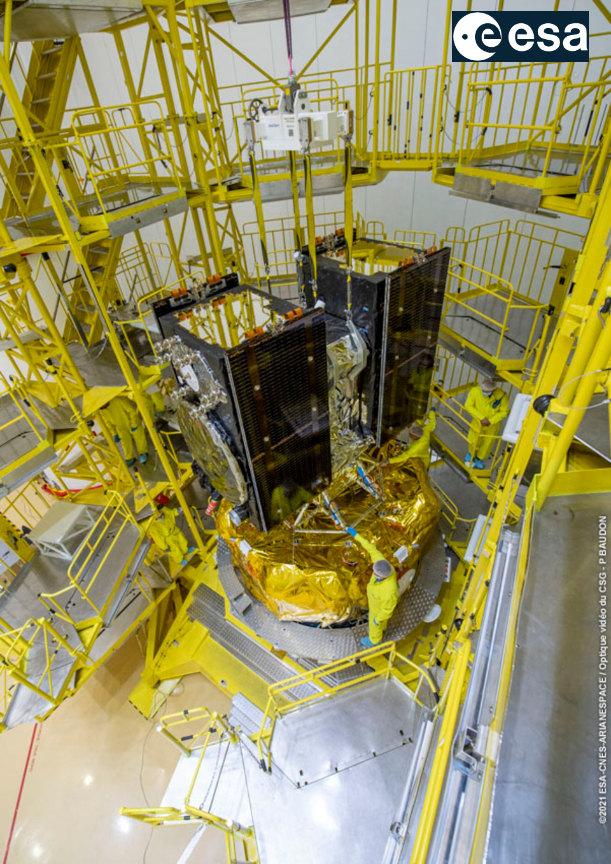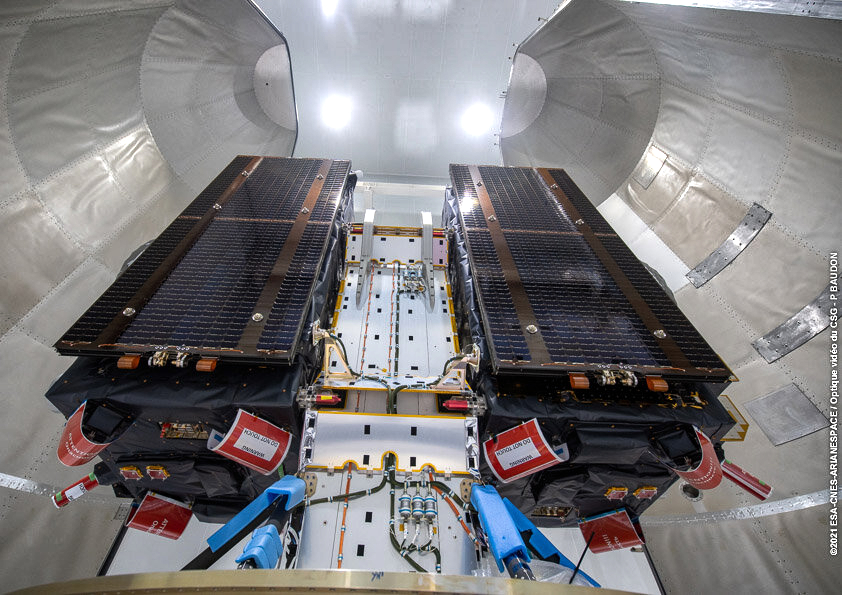
Due to adverse weather conditions at the Guiana Space Center (CSG), the flight VS26 –initially scheduled for December 1– is being postponed.
The Soyuz launch vehicle and spacecraft are in stable and safe conditions.
The new, earliest, targeted launch date is December 2, 2021, at exactly:
> 07:27 p.m. Washington, D.C. time,
> 09:27 p.m. Kourou time,
> 00:27 a.m. Universal time (UTC), on December 3,
> 01:27 a.m. Paris time, on December 3,
> 03:27 a.m. Moscow time, on December 3.
Original article follows…
Europe’s next two Galileo satellites have been attached to the dispenser on which they will ride to orbit, and the launcher fairing that will protect them during the first part of the ascent to orbit has been closed around the pair.
Galileo satellites 27 – 28 are scheduled to be launched for the European Space Agency (ESA) by Soyuz launcher from Europe’s Spaceport in French Guiana on December 2 at 01:31, CE,T (December 1 at 21:31:27, local Kourou time).
Their dispenser has the double duty of securing the two satellites safely in place during the lift off and flight, then deploying the satellites into their target orbit.

The combined satellites plus dispenser were then placed onto their Soyuz Fregat upper stage, which has the job of hauling the pair most of the way up to medium Earth-orbit, before being enclosed in their launch fairing. Galileos meeting Fregat upper stage Galileos meeting Fregat upper stage

The next step will see this combined ‘upper composite’ being taken to the launch site for integration with the other three stages of their Soyuz launcher, after the launcher is installed on the launch pad.
Bastiaan Willemse, ESA Galileo Full Operational Capability Satellites Manager, said “So far, everything has been going according to plan and we are heading towards the ending of a smooth launch campaign, which started in early October.”
These first of a total of 12, Galileo ‘Batch-3’ satellites, manufactured by OHB Systems and their suppliers from across Europe.
The pair arrived from ESA’s ESTEC Test Centre to the integration facility in French Guiana in early October, kicking off a busy launch campaign, including initial dispenser ‘fit checks’, filling with the hydrazine fuel that will be used to manoeuvre them during their 12 years of working life and finalization of their navigation system generation units and uploading of security keys.
These satellites will add to the 26-satellite Galileo constellation already on-orbit and delivering initial services around the globe.
This lift-off will be the 11th Galileo launch in 10 years. Two further launches are planned for next year, to allow Galileo to reach full operational capability in its delivery of services, to be followed by the launches of the rest of the Batch 3 satellites, which are currently all undergoing pre-flight testing.
In parallel to Batch-3’s completion of Galileo First Generation deployment, the new Galileo Second Generation satellites, featuring enhanced navigation signals and capabilities, are already in development with their deployment expected to begin by the end of 2024.

